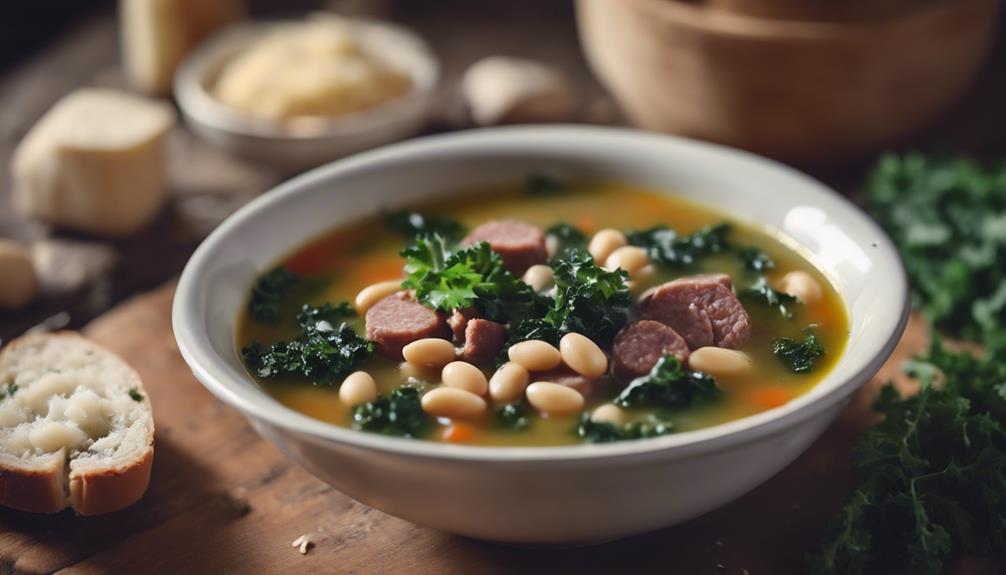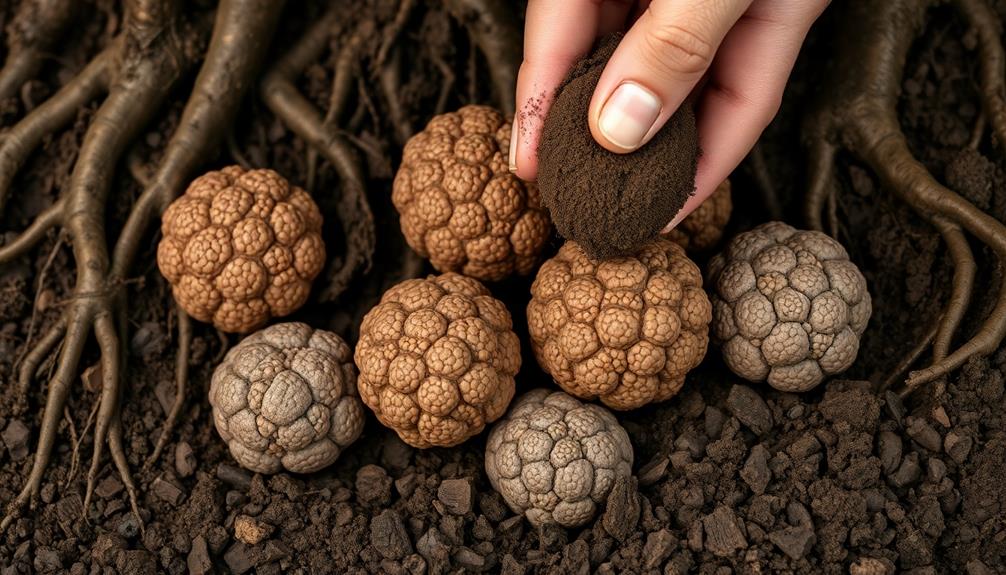Japanese knives are prized by chefs around the world for their exceptional sharpness and durability. You'll notice that they're handcrafted by skilled artisans using high-quality steels like VG-10, ensuring superior edge retention. The knives also feature ergonomic handles that provide comfort during extended use, reducing hand fatigue. This perfect blend of performance and artistry makes every knife a true heirloom piece. Their deep cultural significance, reflecting centuries of craftsmanship, further enhances their appeal. If you're curious about choosing the right knife for your culinary adventures, you'll find plenty of insights ahead.
Key Takeaways
- Japanese knives are renowned for their exceptional sharpness, enabling chefs to achieve cleaner, more precise cuts with minimal effort.
- Handcrafted by skilled artisans, these knives feature meticulous craftsmanship that combines functionality with stunning artistry.
- Their lightweight and ergonomic designs reduce hand fatigue, enhancing comfort during prolonged cooking sessions.
- Made from high-quality, high-carbon steels, they offer remarkable durability and edge retention, minimizing the need for frequent sharpening.
- The cultural heritage and legacy behind Japanese knives elevate their status as coveted heirloom pieces in culinary practices.
Unique Features of Japanese Knives
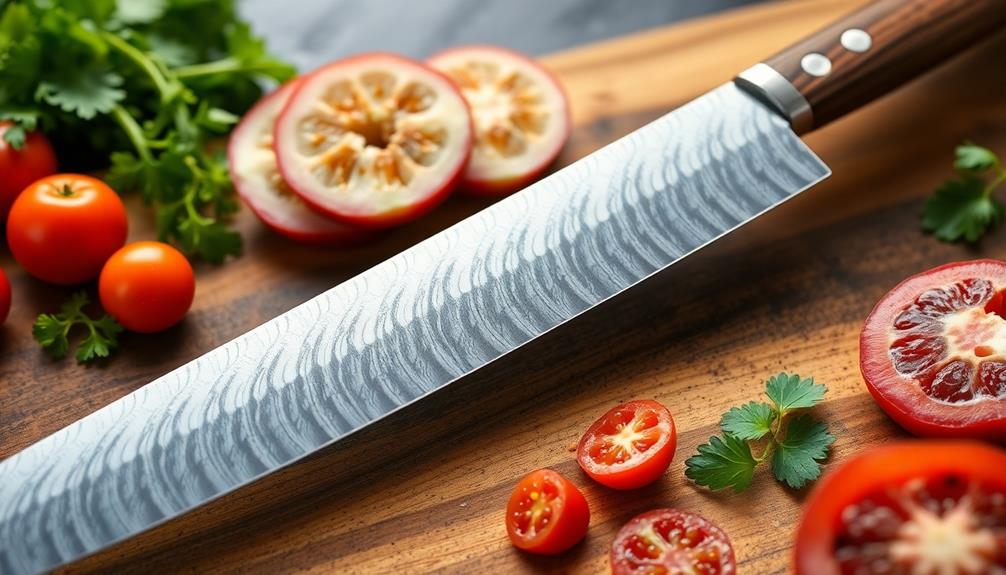
When it comes to culinary precision, Japanese knives stand out for their unique features that elevate your cooking experience. One of the most remarkable aspects is their sharpness, achieved through the use of high-quality steels like VG-10 and AUS-10. These materials offer exceptional hardness, typically ranging from 56-62 HRC, resulting in superior edge retention that keeps your knives sharp longer.
This precision is akin to the meticulous techniques seen in traditional dishes like Red-Braised Pork Belly, where careful preparation and attention to detail result in rich flavors.
Each knife is handcrafted by skilled artisans, ensuring meticulous attention to detail in the blade's design and balance. This craftsmanship not only enhances the knife's aesthetic appeal but also contributes to its ergonomic handles, available in various shapes like oval, octagon, and D-shape.
These designs provide comfort, allowing you to work more efficiently in the kitchen.
The high-carbon content in Japanese knives increases their durability and resistance to wear and corrosion, making them less prone to chipping and bending.
With their ability to achieve finer angles, these knives enhance overall cooking efficiency by reducing the frequency of sharpening.
Investing in Japanese knives means embracing quality and precision, transforming your culinary skills into a delightful experience.
Craftsmanship and Cultural Significance
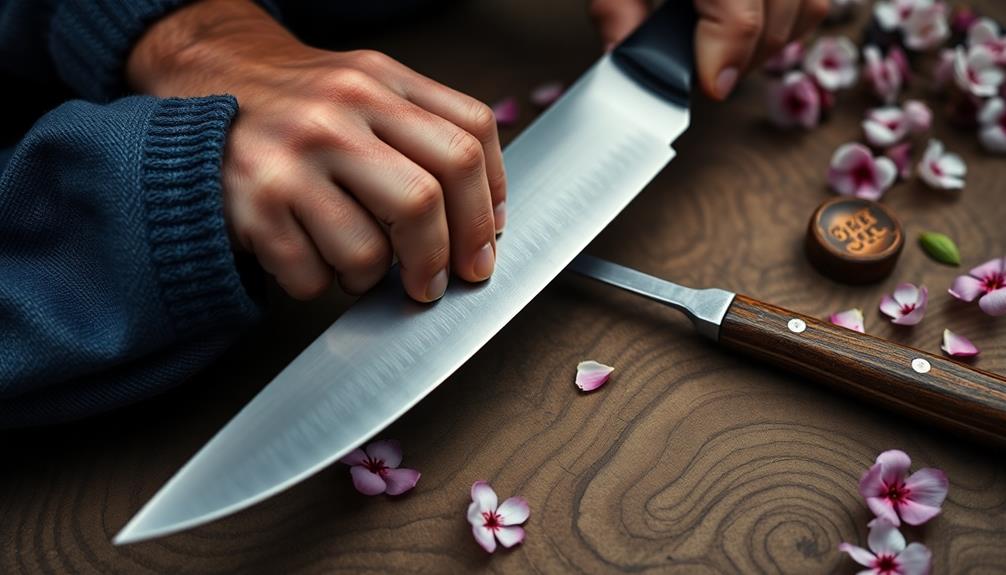
When you hold a Japanese knife, you're not just grasping a tool; you're connecting with centuries of artistry and tradition. Each blade reflects the meticulous craftsmanship passed down through generations, making it a true heirloom.
Much like the intricate preparation of traditional dishes such as Dorayaki (Red Bean Pancake), the skill involved in knife-making showcases a deep respect for culinary excellence. Understanding this heritage enhances your appreciation for the knife's role in your culinary journey.
Artistry in Knife Making
Hand-forged by skilled artisans, Japanese knives embody a rich tradition of craftsmanship that reflects both functionality and artistry. The artistry in knife making shines through in every aspect, from the high-quality materials to the ergonomic handles designed for comfort during extended use. Each handcrafted knife showcases unique features, such as striking Damascus patterns or intricate hammered finishes, enhancing both visual appeal and performance.
The meticulous manufacturing process, rooted in traditional forging methods, guarantees that these knives are not just tools but pieces of art. They stand as symbols of culinary traditions, elevating them to heirloom status cherished by chefs and collectors alike.
| Aspect | Description |
|---|---|
| Craftsmanship | Hand-forged by skilled artisans |
| Materials | High-quality materials used in production |
| Design Features | Unique Damascus patterns and ergonomic handles |
This commitment to artistry and quality makes Japanese knives highly coveted. They embody a dedication to both function and beauty, guaranteeing they remain essential tools in any chef's arsenal. Your appreciation for these knives will grow as you discover the depth of their craftsmanship and cultural significance.
Heritage and Tradition
Japanese knives carry a profound heritage that intertwines craftsmanship with cultural significance. Rooted in centuries-old techniques, these blades are crafted by skilled artisans, particularly in Sakai City, where meticulous attention to detail guarantees exceptional sharpness and durability.
The shift from swordsmiths to knife-makers during the Meiji era underscores the deep connection between traditional samurai craftsmanship and modern culinary tools. This dedication to quality mirrors the approach found in Brazilian cuisine, where each dish reflects a blend of cultural influences and regional ingredients. This transition not only highlights the adaptability of Japanese artisans but also emphasizes the enduring importance of precision and artistry, qualities that are now cherished in both blade-making and global gastronomy. Much like the finest Japanese knives, planning a culinary-inspired journey can lead you to unforgettable destinations, whether savoring new flavors or exploring the best places to stay Amalfi Coast, where breathtaking views meet exceptional local cuisine. Such experiences remind us that craftsmanship, whether in tools or travel, has the power to elevate everyday moments into something extraordinary.
Each knife reflects a commitment to quality, using high-carbon steel that not only enhances performance but also speaks to the artistry involved in their creation. These knives aren't just functional; they embody the spirit of Japanese culture, merging utility with beauty.
The unique designs and ergonomic handles highlight the importance of form and function in Japanese culinary practices. As symbols of quality, Japanese knives are often viewed as heirloom pieces, representing more than just tools; they're cultural artifacts that carry the legacy of generations.
Owning one means possessing a piece of history, a reflection of the dedication and skill of artisans who've honed their craft through the ages. This heritage makes Japanese knives highly coveted by chefs worldwide, bridging the past with the present in every slice.
Performance Advantages
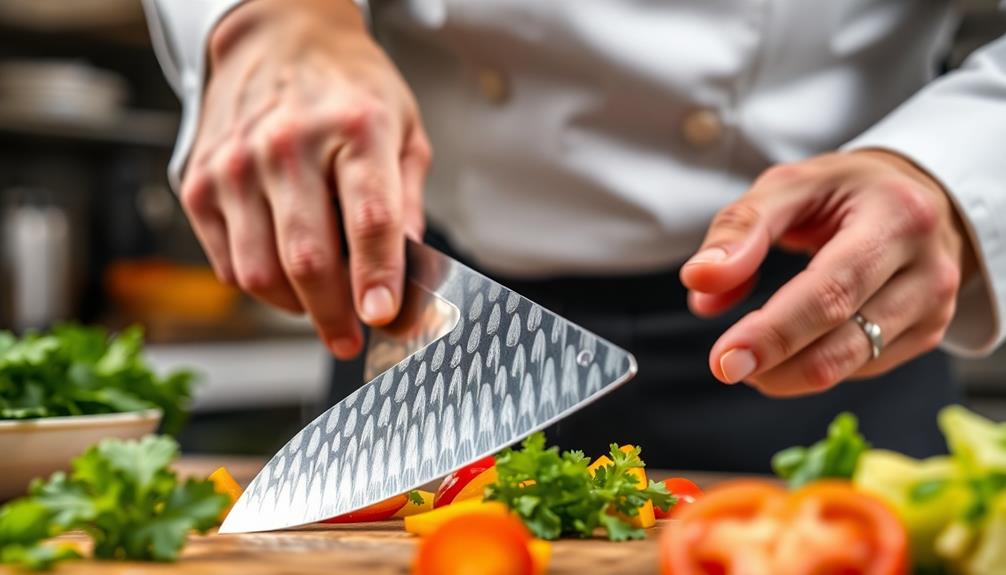
When you use a Japanese knife, you'll immediately notice its exceptional cutting efficiency and sharpness, allowing for cleaner cuts with less effort.
This precision is particularly beneficial when preparing delicate dishes like a Nettle and Potato Soup, as it guarantees that every ingredient is chopped uniformly.
The lightweight and ergonomic design means you can maneuver the knife easily, even during long cooking sessions.
This combination not only enhances your precision but also makes food preparation more enjoyable.
Exceptional Cutting Efficiency
How do Japanese knives achieve such remarkable cutting efficiency? It all starts with high-quality steels forged to a hardness of 56-62 HRC, giving you exceptional edge retention and sharpness. This superior sharpness allows for smoother, cleaner slices, preserving the texture and flavor of your ingredients.
You'll notice how easily the knife glides through food, minimizing resistance and enhancing your cutting efficiency. Just as traditional stuffed pasta showcases regional culinary skills in Italy, these knives reflect the artistry and precision of Japanese craftsmanship.
The lightweight design of these knives reduces hand fatigue, enabling you to perform precision cuts for extended periods without discomfort. You can focus on intricate tasks with confidence.
Plus, the ergonomically designed handles come in various shapes, providing a comfortable grip that improves control as you work.
Many Japanese knives also feature unique designs, such as hammered prints or Damascus patterns. These not only add aesthetic appeal but also reduce food sticking, enhancing overall cutting performance.
With these knives, you're not just investing in tools; you're elevating your culinary experience. Whether you're a professional chef or a home cook, the exceptional cutting efficiency of Japanese knives will transform your approach to food preparation.
Lightweight and Ergonomic Design
Balancing lightweight design with ergonomic features, Japanese knives offer chefs unparalleled performance advantages in the kitchen. Their lightweight design enhances precision cutting while reducing fatigue during long cooking sessions. You'll appreciate how the ergonomic handles, available in various shapes like oval, octagon, and D-shape, provide comfort and a natural grip, making each cutting task feel effortless.
| Feature | Benefit | Impact on Performance |
|---|---|---|
| Lightweight Design | Reduces fatigue | Enhances cooking efficiency |
| Ergonomic Handles | Provides comfort | Improves control and grip |
| Tapered Blade Profile | Aids in precision cutting | Enables efficient cutting motions |
The meticulous balance of Japanese knives guarantees they feel like an extension of your hand, allowing for greater control and maneuverability. This design not only speeds up your cutting tasks but also enhances the overall cooking experience. With these knives, you'll find that every slice is more manageable, making them ideal for intricate tasks. Investing in a Japanese knife means investing in your comfort and efficiency in the kitchen.
Investment Value and Cost Justification
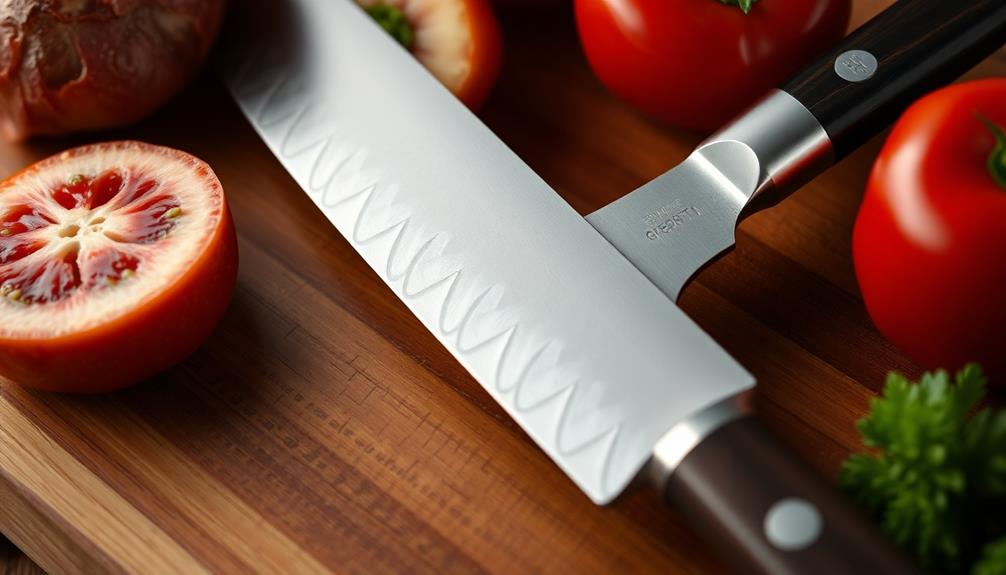
Investing in Japanese knives can seem intimidating due to their higher price tag, but the long-term benefits make them a smart choice for both chefs and culinary enthusiasts. The meticulous craftsmanship and superior materials used in these knives justify their investment value.
Unlike mass-produced alternatives, Japanese knives boast remarkable longevity, often lasting decades with proper care. This durability means you'll need fewer replacements over time, making cost justification straightforward. Additionally, just as the rich blend of spices enhances the flavor of dishes like Mushroom Masala, the precision and sharpness of Japanese knives elevate your culinary creations.
Moreover, many Japanese knives, especially limited editions and artisan-crafted pieces, can appreciate in value, transforming them into collectible investments. The exceptional edge retention and sharpness reduce the need for frequent sharpening, leading to lower long-term maintenance costs.
As a culinary professional, you'll find that these knives not only enhance your cooking experience but also offer financial advantages. Collectors and culinary experts alike appreciate the unique craftsmanship and rich heritage behind Japanese knives, further enhancing their desirability and potential resale value in the market.
Choosing the Right Japanese Knife
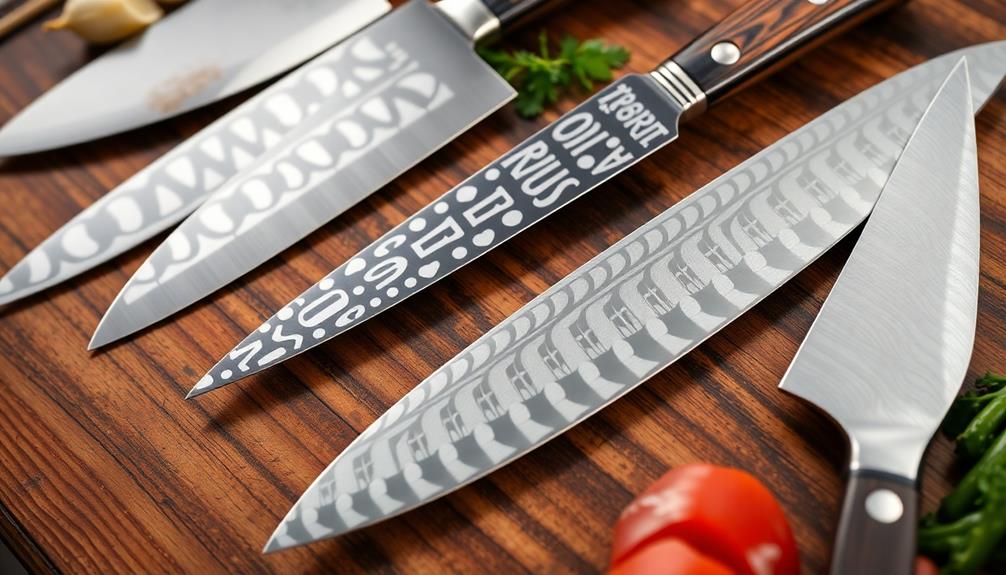
With the investment value of Japanese knives established, it's time to focus on selecting the right one for your kitchen. When choosing the right Japanese knife, consider what best suits your culinary needs. You might opt for the versatile Santoku for general tasks or a specialized Nakiri for vegetable prep. If you need a knife that excels in various cutting techniques, the Gyuto is a fantastic multifunctional choice.
Here's a quick overview to help you make an informed decision:
| Type | Features |
|---|---|
| Santoku | Versatile for slicing, dicing, and mincing |
| Gyuto | Excellent for various cutting techniques |
| Nakiri | Specialized for vegetable preparation |
Take time to assess the handle design—options like octagonal or D-shaped can greatly enhance your comfort and control. Additionally, make sure you choose a knife with the right blade material; high-carbon steels like VG-10 are perfect for professional use due to their sharpness and edge retention. Reflect on your cooking style to find a knife that aligns with your habits, boosting both efficiency in the kitchen and your overall enjoyment.
Meticulous Manufacturing Process
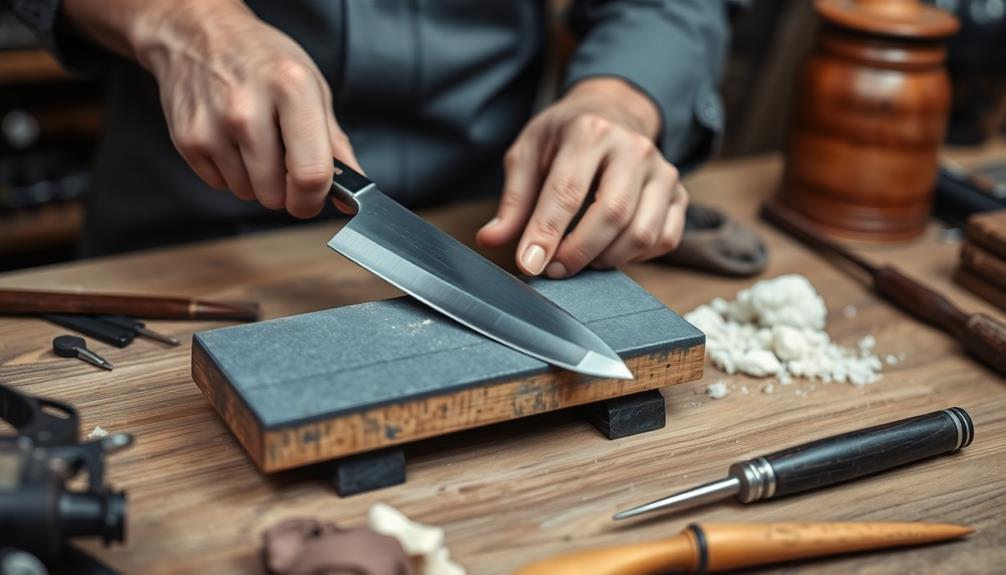
The meticulous manufacturing process of Japanese knives is a blend of ancient techniques and modern precision, ensuring each blade isn't only sharp but also durable. This process reflects the high level of craftsmanship found in regions like Sakai City, where artisans dedicate themselves to perfecting each detail.
Japanese culinary traditions, such as the use of Yasai Itame (vegetable stir-fry), often emphasize the importance of quality tools, making these knives an essential part of the cooking experience.
Here's what makes this process exceptional:
- Hand-forging: Each knife begins with skilled artisans who hand-forge the blade, shaping it to achieve exceptional sharpness and balance.
- High-quality materials: They use high-carbon and powdered steels, which enhance the knife's durability and superior edge retention.
- Heat treatment: The blades undergo a precise heat treatment, optimizing hardness while maintaining flexibility for slicing.
- Precise sharpening: Finally, each knife is meticulously sharpened, ensuring it performs flawlessly in the hands of culinary professionals.
This attention to detail not only enhances functionality but also transforms each knife into a unique piece of art.
As a result, Japanese knives are highly sought after, appreciated not just for their performance but also for the heritage and dedication that goes into their creation.
Global Surge in Popularity
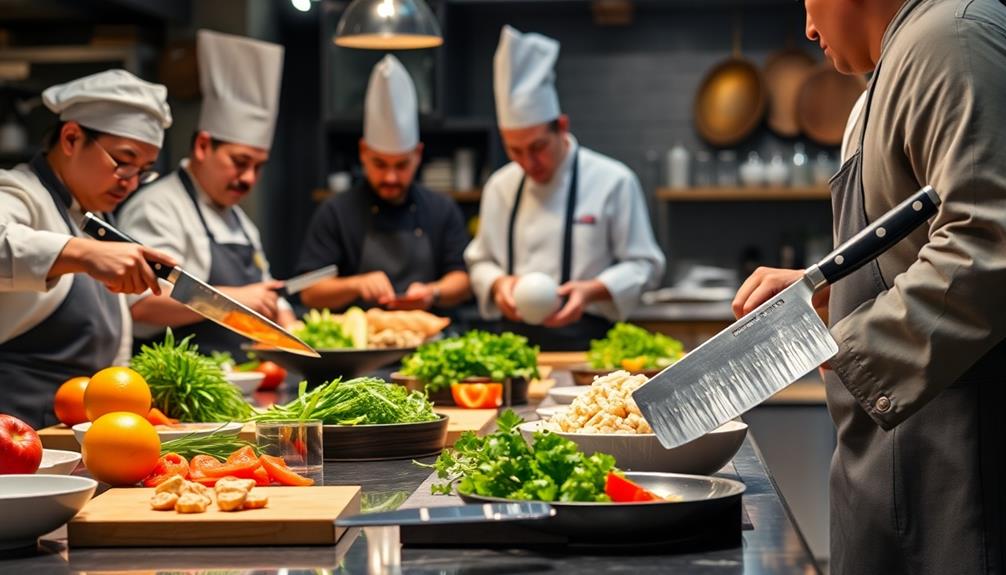
Japanese knives are experiencing a remarkable surge in popularity across the globe, enchanting both professional chefs and home cooks. This global surge in popularity can be attributed to their exceptional craftsmanship and high-quality materials, which set them apart from other culinary tools.
Following UNESCO's recognition of Japanese cuisine, the demand for authentic Japanese culinary tools, particularly knives, has skyrocketed. Additionally, as culinary enthusiasts explore diverse global cuisines, they often seek out high-quality tools to enhance their cooking experiences, just as one might appreciate the intricate flavors of Kue Putu, a traditional Indonesian dessert that showcases craftsmanship.
The pandemic-induced increase in home cooking has led many to invest in high-quality kitchen tools, and Japanese knives have become a top choice. Their unique blend of traditional craftsmanship and modern design appeals to a diverse range of culinary professionals and enthusiasts alike.
As you explore your cooking journey, you'll find that the precision and performance of these knives enhance your culinary experiences.
Exports of Japanese knives primarily target North America and Western Europe, reflecting their growing status in international culinary markets. Whether you're a seasoned chef or a budding home cook, owning a Japanese knife means embracing quality and artistry in your kitchen.
This rising trend shows no signs of slowing down, as more people recognize the value of these exceptional tools in elevating their culinary creations.
Frequently Asked Questions
What Is so Special About Japanese Knives?
Japanese knives stand out due to their exceptional sharpness, high-quality materials, and traditional craftsmanship. You'll appreciate their ergonomic designs and unique finishes, which not only enhance performance but also add beauty to your kitchen tools.
Why Japanese Chef's Knives Are so Expensive?
Did you know some Japanese knives can reach a hardness of 62 HRC? Their expense stems from high-quality materials, traditional craftsmanship, limited production, and unique designs, all contributing to their exceptional performance and lasting value.
What Country Makes the Best Knives in the World?
When considering the best knives, you might lean toward Japanese craftsmanship. Their unique blend of traditional techniques and high-quality materials creates exceptional tools, offering unmatched sharpness and performance that can elevate your culinary skills considerably.
What Knife Does Gordon Ramsay Use and Why?
Gordon Ramsay uses Shun knives for their exceptional sharpness and balance. You'll appreciate their high-carbon steel, ensuring durability and less sharpening. Their ergonomic handles provide comfort, making food preparation easier and more efficient in the kitchen.
Conclusion
So, you might think a knife is just a knife, right? But when it comes to Japanese knives, it's like comparing a humble potato to a Michelin-star dish. Their unique features, unmatched craftsmanship, and performance advantages make them more than just tools—they're culinary art. Investing in one isn't just about cutting; it's about elevating your cooking experience. So, go ahead, wield a piece of Japan in your kitchen, and watch your culinary skills slice through mediocrity!


